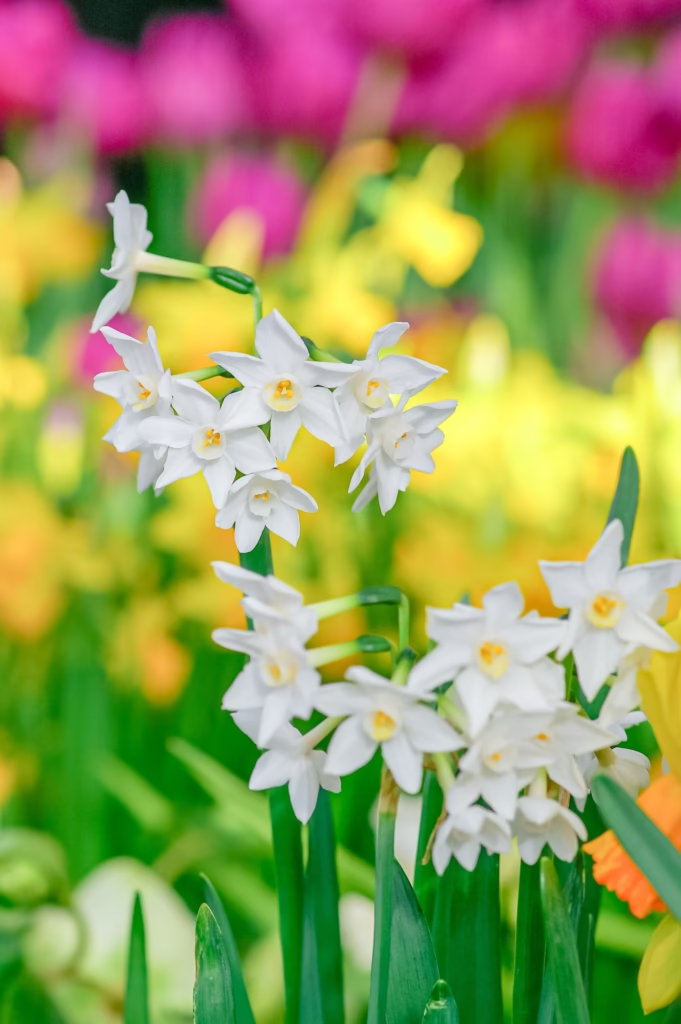
Paperwhite narcissus, known for their fragrant blooms and ease of care, make excellent additions to indoor and outdoor gardens. These bulbs are popular for holiday decorations and early spring displays, offering bright white flowers that add elegance to any setting. With proper care, paperwhites can thrive in various conditions, providing beautiful blooms year after year. Hope you enjoy this post on How to grow Paperwhite Narcissus.
Ideal Growing Zones for Paperwhite Narcissus
Paperwhite narcissus grows best in USDA zones 8–11 when planted outdoors. In cooler climates, gardeners can enjoy these flowers indoors during the winter. While paperwhites are not frost-tolerant, they can be treated as annuals in colder regions or grown indoors for seasonal enjoyment.
How to Plant Paperwhite Narcissus
Planting paperwhite narcissus requires well-draining soil and a sunny location. For outdoor planting, prepare the soil by loosening it to a depth of 8–10 inches. Mix in compost or organic matter to improve drainage and fertility.
When planting bulbs, place them 3–4 inches deep with the pointed end facing up. Space each bulb 3–4 inches apart to allow for proper growth. Water the soil thoroughly after planting to settle the bulbs. For indoor planting, use a shallow container filled with gravel, decorative stones, or potting soil. Arrange the bulbs close together but avoid overcrowding. Water the container until the base of the bulbs is just touching the water, and keep them in a bright location.
Light and Water Requirements
Paperwhites need bright, indirect sunlight to thrive. Outdoors, plant them in a location that receives at least 6 hours of sunlight daily. Indoors, place containers near a sunny window or under grow lights.
Water paperwhites regularly, keeping the soil moist but not soggy. For indoor containers, maintain water levels just below the base of the bulbs to encourage root growth. Avoid overwatering, as it can cause the bulbs to rot.
Fertilizer Needs
Paperwhite narcissus does not require much fertilization to bloom. When planting outdoors, adding compost or a balanced bulb fertilizer can boost growth. Indoor plantings typically rely on nutrients stored in the bulbs, so additional feeding is unnecessary. After blooms appear, use a diluted liquid fertilizer if the leaves begin to yellow.
Caring for Paperwhites After Blooming
After the flowers fade, trim the spent blooms to prevent the plant from focusing energy on seed production. Leave the foliage in place until it turns yellow and dies back naturally. This process allows the bulbs to store energy for future blooms.
For outdoor paperwhites, stop watering once the leaves begin to yellow. Allow the bulbs to dry out completely if you plan to dig them up for storage. For indoor paperwhites, remove the bulbs from the container once the foliage dies back. Store them in a cool, dry place until the next planting season.
When and How to Divide Paperwhite Bulbs
Dividing paperwhite bulbs helps maintain healthy growth and encourages better blooms. Over time, bulbs produce offsets, which can lead to overcrowding and reduced flowering.
Divide bulbs every 3–4 years or when clumps become too dense. The best time to divide paperwhites is in late summer or early fall after the foliage has died back. Carefully dig up the bulbs using a garden fork or trowel. Separate the offsets from the parent bulbs, making sure each division has healthy roots.
Replant the bulbs immediately in prepared soil, following the same depth and spacing guidelines. If storing bulbs, allow them to dry for a few days before placing them in a paper bag or mesh sack. Keep the stored bulbs in a cool, dry location until you are ready to plant them.
Common Problems and Solutions
Paperwhite narcissus generally faces few issues, but occasional problems may arise. Bulb rot often occurs due to overwatering or poor drainage. To prevent this, ensure the soil drains well and avoid keeping bulbs in standing water.
Leggy growth can result from low light conditions. Move indoor paperwhites to a brighter location or rotate them regularly to encourage even growth. If stems grow too tall, support them with stakes or decorative twigs.
Pests such as aphids or spider mites may occasionally appear. Rinse the plants with water or use insecticidal soap to eliminate infestations.
Happy Narcissus Gardening!
Growing paperwhite narcissus offers a simple way to enjoy fragrant, elegant blooms both indoors and outdoors. By planting in well-draining soil, providing adequate sunlight, and watering properly, you can encourage healthy growth and vibrant flowers. With proper after-bloom care and occasional division, paperwhites can continue to brighten your home and garden for years to come.
Please be sure to check out my Gardening Blog Post Page for more tips on all types of gardening. Including Seed Saving, Seed Starting, Orchids, Water Gardening, Coldframe Gardening, Indoor Bulb Gardening, Hydroponics, Container Gardening, Mums, Herbs, African Violets, planting Bulbs, Flower Gardening, Vegetable and Fruit Gardening, Indoor Houseplants of all kinds, Cactus, Succulents, Hanging plants, Deer resistant plants and even Bird, Bee, Butterfly and Hummingbird Gardens!
